Do you have a garage door that won’t go down? Maybe your garage door won’t stay down? Whatever your issue, one thing’s for sure. This can become quite frustrating. Instead of calling a technician, try and fix the problem by using these easy tips.
Problems with the sensors
For those who are unfamiliar with how garage door sensors work, there are two sensors, each positioned on a side. One of the sensors sends an infra-red beam to the other sensor. If any of these sensors should happen to get bumped or misaligned, the infra-red beam would be thrown off and the garage door won’t go down. If this is your situation, the first thing you’ll want to do is make sure these sensors are properly lined up.
Start by inspecting the LEDs on each of the sensors to make sure they’re both displaying a solid red light. It’s important to note though that some garage door opener systems may display a solid green light instead. It really depends on the model you have. If the LEDs are flashing, then you’ll know that they are not aligned correctly.
If this is the case, check the mounting brackets. When these brackets get bumped or banged, they can cause the sensors not to line up right. To help you align these two sensors, use a long piece of string or rope and stretch it from one sensor to the other. This will help you visually line them up. From there, simply adjust your brackets until both of the LED lights are displaying a solid, red dot.
Another thing that can prevent your garage door from closing are obstructions that are blocking the lenses. Like mentioned above, there are two lenses, one on each side. If something is blocking the safety beam, then the garage door will not close. These obstructions can include anything like a garden tool, a lawn chair, or anything else in the way.
Now, if your garage door still won’t go down after you’ve made sure the sensors are properly aligned and there’s no obstructions, you’ll want to take a damp cloth and wipe down the lenses of the sensors. Overtime, these lenses can become coated with grime, dirt, and even sawdust. As a result, the infra-red beam can’t connect to the opposite sensor and close the garage door. Sometimes the issue is that easy.
Force your garage door closed
If you’ve tried everything listed above, and your garage door still won’t go down, you can try to force it to close. This only works on certain electric models. On the switch pad located on the wall, press and hold the pressure plate for a few seconds. Doing this will force your garage door to close, but like just mentioned, this method only works with certain models.
Manual garage doors
If your garage has a manual door, meaning one that’s opened and closed by hand, and the garage door refuses to go down, do not force it. This could cause unnecessary damage.
Start by checking the rack and the rollers to see if something has become stuck. You’ll also want to see if the track has become twisted or if the cables are worn or bound up. It’s important to note that if one of the cables does need to be repaired, you make sure you call a professional to handle this matter. These cables are quite dangerous and can even cause bodily injury if you have no idea what you’re doing.
Electrical connections
Electrical connections can also be the reason why a garage door isn’t working properly. They can be a contributing factor when your garage door won’t going down, won’t stay shut, and won’t opening all together. Overtime, the electrical connections can corrode and cause the garage door opener to malfunction.
Try and pull out the wire plug going into each of the sensors. When you pull the wire out, make sure you hold onto the plug and not the wire itself. Once removed, wipe the end off or blow it off with an air compressor and reinsert the wire into the sensor. This isn’t a guaranteed fix, but it does tend to work a good portion of the time.
Making the necessary adjustments on your garage door opener
When a garage door opens up too far, the trolley can crash into the stopper bolt so hard that it can become jammed. Not only is this a hassle, it’s also not very good for your garage door, the tracks, and the cables. So, how do you stop your garage door from going up too far?
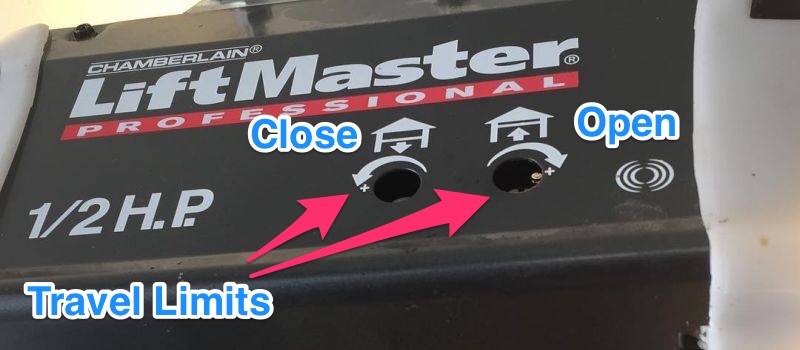
The limit adjusters
Start by making sure your garage door is open all the way. On the main console, the box that hangs from the ceiling, you’ll see a few different nobs and/or buttons. Locate the limit adjusters. The limit adjusters control how far the garage door goes up, and how far it goes down. You should also find buttons or nobs that will adjust the force too.
As you tinker with the limit adjusters, you’ll more than likely have to adjust the force too. If you have a hard time finding these nobs and/or buttons, they may be hidden under the outer cover. Simply take this cover off to get access to them. It’s important to emphasize that typically one turn of a nob will equal 2 inches. Also, after you make an adjustment, you’ll have to run the garage door through a full cycle before you can make any other adjustments.
If your garage door opens part of the way, at least 5 feet, and then stops, you’ll want to turn the up-limit knob to the right. You’ll also want to make sure you keep the trolley about 2 to 4 inches from the protection bolt. Now, if your garage door stops opening up before it gets to 5 feet, you’ll need to adjust the open or up force nob. When you adjust this, the force at which it pulls will increase. (Always perform a safety test after making any changes to the force limit adjustments.)
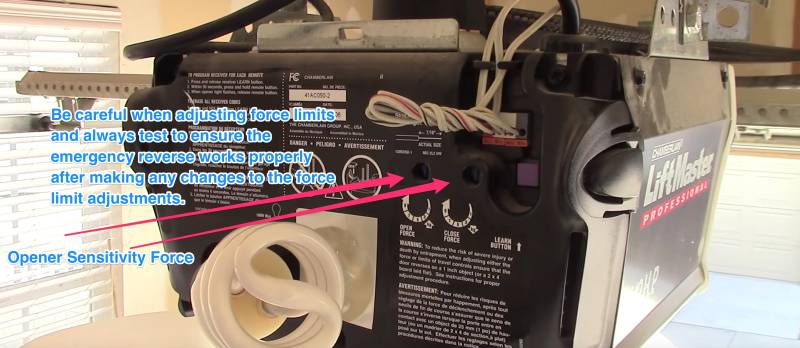
The force adjusters
A garage door that won’t close all the way may also need to be adjusted. However, if this is your issue, make sure you check the sensors first. If the problem isn’t your sensors, then you’ll need to increase the down travel. Do this by turning the down limit nob counterclockwise.
Finally, let’s say your garage door closes but bounces on the ground and then opens up again, you’ll want to decrease the down travel. Do this by turning the limit adjustment nob clockwise.
Performing a safety test
Lastly, you’ll want to perform a safety test. Simply lay a 2-by-4 on the ground and let the garage door come down on top of it. If your garage door hits it, bounces up, and starts to open again, your garage door is working well. However, if your garage door doesn’t bounce back up, then you know you have a problem. To fix this issue, increase the down limit one quarter turn. You’ll then want to test it again, and if it’s not right, keep adjusting the down limit nob until your garage door hit the board and bounces back up.
- What to Do if Your House Smells Like Gas but There’s No Leak - February 6, 2023
- Why Is There a Burning Smell Coming From My Vents? - August 16, 2022
- How to Remove the Musty Smell From Your Air Conditioner - August 16, 2022

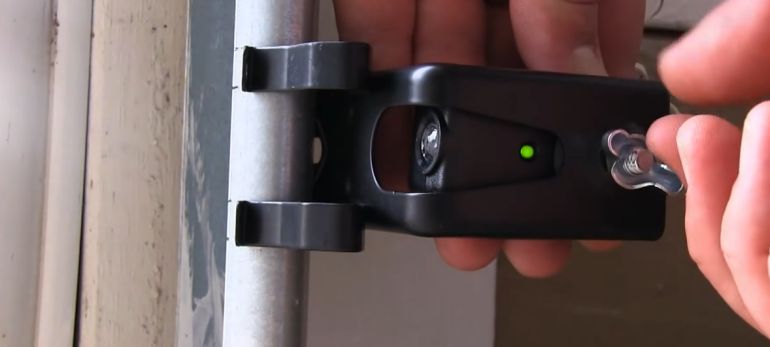
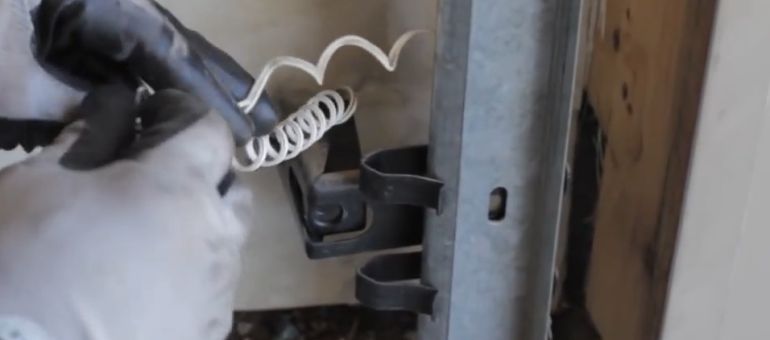
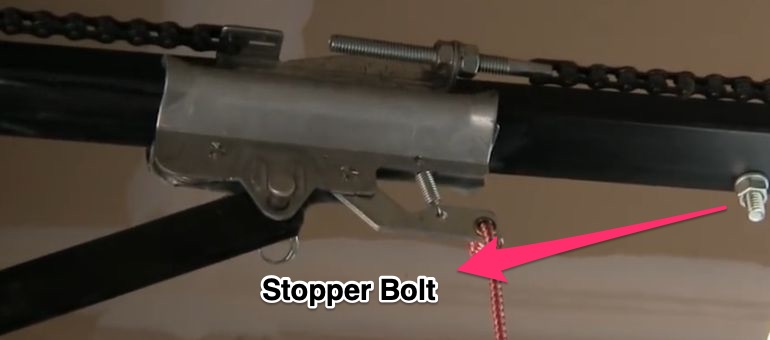
Dieter Ruth
Thursday 17th of November 2022
Thank you for having this troubleshooting online. My garage door opened but wouldn’t close. It kept coming down partially and then going back up. I read some of your advice and cleaned the photo eyes and made sure nothing was against it them. Afterwards, I tried it again and this time it worked. Thank you so much. All I could think of was how much a service call would cost. I don’t know much about garage doors, but I like it that people like you are kind enough to put tips online that can help us avoid big costs when it’s a very simple thing that went wrong. I appreciate that this information was online, Michael. God bless you.